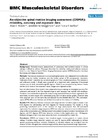| dc.contributor.author | Breen, Alan | |
| dc.contributor.author | Muggleton, Jennifer M | |
| dc.contributor.author | Mellor, Fiona | |
| dc.date.accessioned | 2018-06-25T13:20:59Z | |
| dc.date.available | 2018-06-25T13:20:59Z | |
| dc.date.issued | 2006 | |
| dc.identifier.citation | Breen, A. C., Muggleton, J. M. and Mellor, F. E., 2006. An objective spinal motion imaging assessment (OSMIA): reliability, accuracy and exposure data. BMC Musculoskelet Disorders, 7, 1 https://doi.org/10.1186/1471-2474-7-1 | en |
| dc.identifier.issn | 1471-2474 | |
| dc.identifier.uri | https://aecc.archive.knowledgearc.net/handle/123456789/32 | |
| dc.description | Available under License - Creative Commons Attribution: https://creativecommons.org/licenses/by/4.0/ | en |
| dc.description.abstract | Background:
Minimally-invasive measurement of continuous inter-vertebral motion in clinical settings is difficult to achieve. This paper describes the reliability, validity and radiation exposure levels in a new Objective Spinal Motion Imaging Assessment system (OSMIA) based on low-dose fluoroscopy and image processing.
Methods:
Fluoroscopic sequences in coronal and sagittal planes were obtained from 2 calibration models using dry lumbar vertebrae, plus the lumbar spines of 30 asymptomatic volunteers. Calibration model 1 (mobile) was screened upright, in 7 inter-vertebral positions. The volunteers and calibration model 2 (fixed) were screened on a motorised table comprising 2 horizontal sections, one of which moved through 80 degrees. Model 2 was screened during motion 5 times and the L2-S1 levels of the volunteers twice. Images were digitised at 5fps.
Inter-vertebral motion from model 1 was compared to its pre-settings to investigate accuracy. For volunteers and model 2, the first digitised image in each sequence was marked with templates. Vertebrae were tracked throughout the motion using automated frame-to-frame registration. For each frame, vertebral angles were subtracted giving inter-vertebral motion graphs. Volunteer data were acquired twice on the same day and analysed by two blinded observers. The root-mean-square (RMS) differences between paired data were used as the measure of reliability.
Results:
RMS difference between reference and computed inter-vertebral angles in model 1 was 0.32 degrees for side-bending and 0.52 degrees for flexion-extension. For model 2, X-ray positioning contributed more to the variance of range measurement than did automated registration. For volunteer image sequences, RMS inter-observer variation in intervertebral motion range in the coronal plane was 1.86 degrees and intra-subject biological variation was between 2.75 degrees and 2.91 degrees. RMS inter-observer variation in the sagittal plane was 1.94 degrees. Radiation dosages in each view were below the levels recommended for a plain film.
Conclusion:
OSMIA can measure inter-vertebral angular motion patterns in routine clinical settings if modern image intensifier systems are used. It requires skilful radiography to achieve optimal positioning and dose limitation. Reliability in individual subjects can be judged from the variance of their averaged inter-vertebral angles and by observing automated image registration. | en |
| dc.language.iso | en | en |
| dc.publisher | BMC Musculoskeletal Disorders | en |
| dc.title | An objective spinal motion imaging assessment (OSMIA): reliability, accuracy and exposure data | en |
| dc.type | Article | en |
| dc.identifier.doi | https://doi.org/10.1186/1471-2474-7-1 | |
